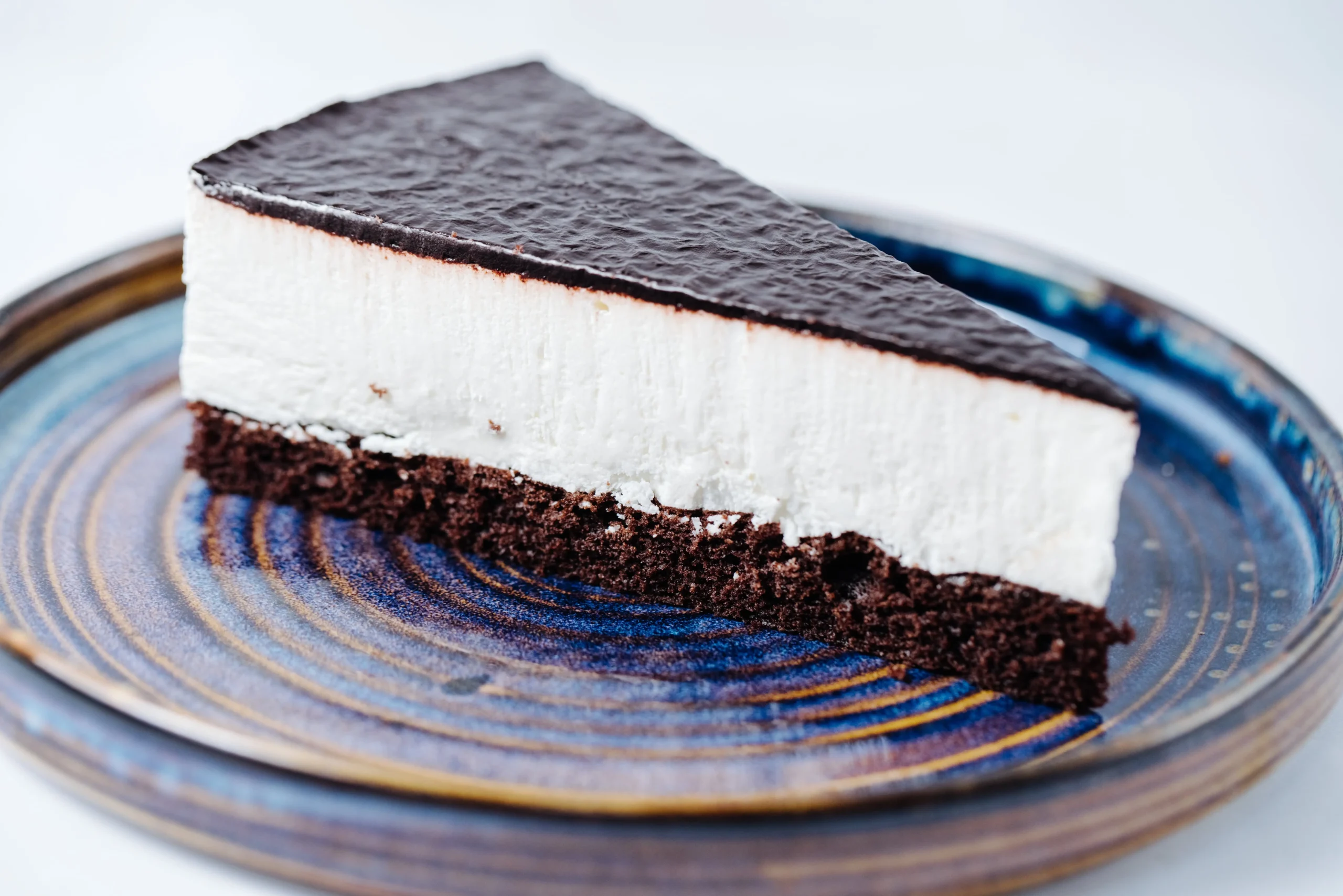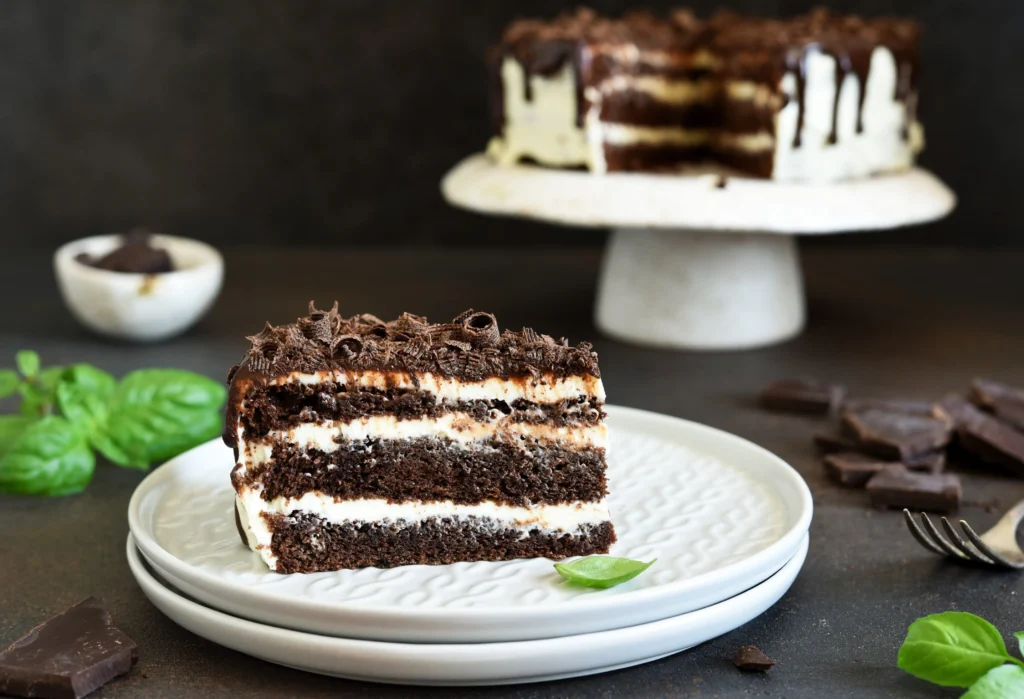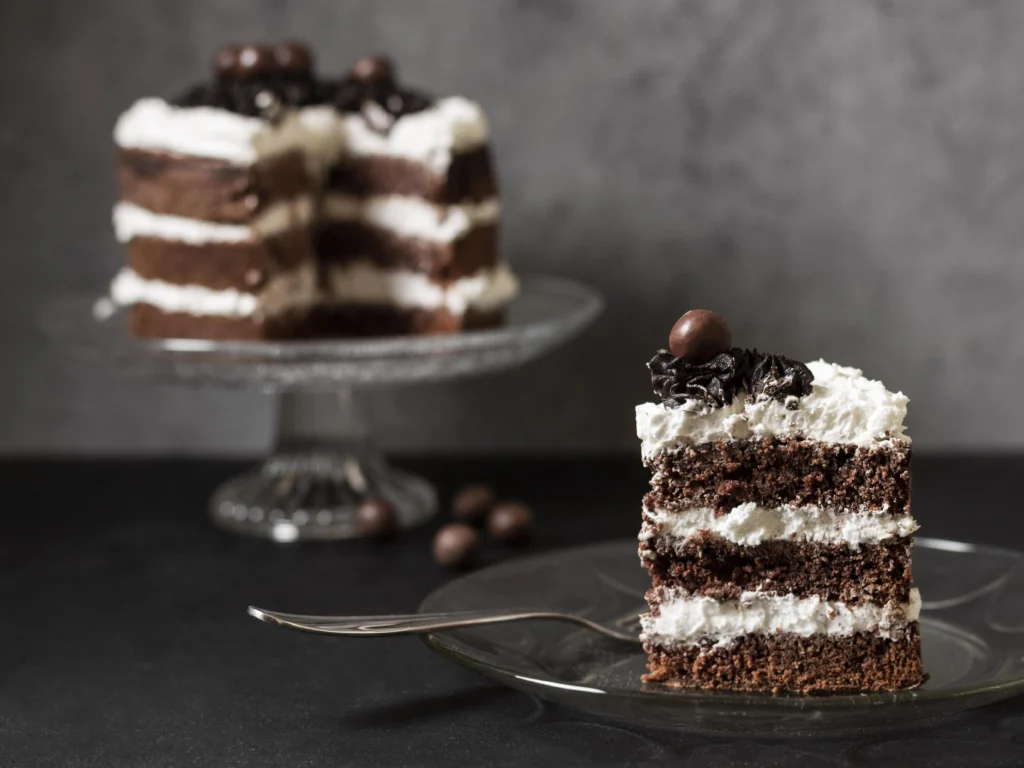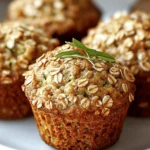Chocolate Cream Cheese Cake
Chocolate Cream Cheese Pound Cake, a delectable fusion of rich chocolate and smooth cream cheese, represents a delightful twist on the traditional pound cake. This dessert, known for its dense yet tender crumb, has evolved from the classic recipe of equal parts flour, butter, sugar, and eggs, to incorporate the indulgent flavors of chocolate and the tangy creaminess of cream cheese. Perfect for both special occasions and everyday treats, this variant stands out in the world of baking as a testament to culinary creativity and the enduring appeal of comfort food. In this article, we’ll explore the origins, ingredients, and techniques that make the Chocolate Cream Cheese Pound Cake a beloved choice for bakers and dessert lovers alike.
Overview of the Pound Cake
The pound cake, a time-honored classic in the world of baking, has its roots in a simple formula: a pound each of flour, butter, sugar, and eggs. This quintessential recipe has evolved over centuries, adapting to various cultural tastes and ingredients. The traditional pound cake, known for its dense yet tender crumb, has been a staple in both family kitchens and professional bakeries, symbolizing the essence of home-style comfort baking.
The Rise of Chocolate Cream Cheese Cake
In recent years, the chocolate cream cheese pound cake has emerged as a delightful twist on the classic. This variant melds the richness of chocolate with the creamy tang of cream cheese, creating a decadent and moist texture. The addition of chocolate not only enhances the flavor but also introduces a luxurious depth to the traditional pound cake, making it a favorite among chocolate lovers.
Importance in Baking Culture
The chocolate cream cheese pound cake holds a special place in both home baking and professional culinary arts. It represents a fusion of traditional baking with modern flavors, showcasing the versatility of the pound cake. This cake is often a centerpiece at gatherings, reflecting the warmth and creativity of the baker, and continues to be a beloved choice for special occasions and everyday indulgences.
Ingredients Breakdown: Crafting the Perfect Chocolate Cream Cheese Pound Cake
Key Ingredients Breakdown
- Flour: The backbone of the cake, providing structure. Typically, all-purpose flour is used for its balanced protein content, which contributes to a tender crumb.
- Impact on Texture: The right type of flour ensures a balance between a firm structure and a soft texture.
- Cream Cheese: Adds moisture and a subtle tang, enhancing the cake’s richness. It’s crucial for the velvety texture.
- Role in Moisture and Texture: Cream cheese contributes to a denser, creamier crumb compared to traditional pound cakes.
- Chocolate: The type and quality of chocolate significantly affect the flavor. Dark chocolate (60-70% cacao) is preferred for its intense flavor.
- Types and Percentages: Higher cacao percentage offers a deeper chocolate taste.
- Cocoa Powder: Comes in two types – natural and Dutch-processed.
- Dutch Process vs. Natural: Dutch-processed cocoa powder is less acidic and has a smoother, richer flavor, making it ideal for this cake.
- Additional Ingredients:
- Butter: For richness and a creamy texture.
- Sugar: Adds sweetness and aids in caramelization.
- Eggs: Provide structure and act as a binding agent.
Ingredient Quality and Selection for Chocolate Cream Cheese Cake
- Importance of Quality: High-quality ingredients can significantly elevate the cake’s flavor and texture.
- Flavor Depth: Premium ingredients contribute to a more nuanced and rich flavor profile.
- Selecting the Best Ingredients:
- Flour: Opt for a reputable brand of all-purpose flour.
- Cream Cheese: Full-fat versions provide better texture and flavor.
- Chocolate: Choose high-quality chocolate with a high cacao content for a luxurious taste.
- Cocoa Powder: Dutch-processed cocoa for a smoother chocolate flavor.
Step-by-Step Guide to Baking the Perfect Chocolate Cream Cheese Cake
Preparation Before Baking
- Mise en Place:
- Importance: Ensures all ingredients and tools are ready, preventing mistakes and saving time.
- Components: Includes measuring ingredients, softening butter and cream cheese, and preparing the baking pan.
- Preheating and Pan Preparation:
- Oven Preheating: Crucial for even baking. Preheat to the recipe’s specified temperature.
- Pan Preparation: Use a light-colored metal tube pan, greased and floured, to prevent sticking and ensure even baking.
Creating the Chocolate Base
- Process:
- Melt chocolate and cream cheese together, creating a smooth and uniform mixture.
- Incorporate cocoa powder and boiling water, ensuring no lumps remain.
- Add vanilla extract for flavor enhancement.
- Tips:
- Use a double boiler for melting to avoid burning the chocolate.
- Ensure the mixture is cool enough before adding to other ingredients to prevent cooking the eggs.
The Creaming Method: Butter, Sugar, and Eggs
- Technique:
- Cream butter and sugar until light and fluffy, which introduces air into the mixture, contributing to a lighter texture.
- Add eggs one at a time, fully incorporating each before adding the next. This maintains the emulsion and aerates the batter.
- Impact on Cake’s Texture:
- Proper creaming results in a softer, more delicate crumb.
- Ensures even distribution of air for a uniform texture.
Combining Ingredients and Baking
- Alternating Dry and Wet Ingredients:
- Add dry ingredients (flour, salt, baking powder) and wet ingredients (chocolate mixture) alternately to the creamed mixture.
- This method prevents the batter from becoming too thick or thin, ensuring a consistent texture.
- Baking Time and Temperature Specifics:
- Bake at a moderate temperature to allow the cake to rise evenly without burning.
- The cake is done when a skewer inserted into the center comes out clean.
Advanced Baking Tips for the Ultimate Chocolate Cream Cheese Cake
Achieving the Perfect Texture and Flavor
- Mixing Techniques:
- Avoid overmixing the batter after adding flour to prevent developing too much gluten, which can make the cake tough.
- Gently fold in the dry ingredients to maintain the airiness of the batter.
- Flavor Enhancement:
- Use high-quality vanilla extract for a richer flavor.
- A pinch of salt can balance and enhance the chocolate flavor.
Ganache and Cocoa Whipped Cream
- Ganache Recipe:
- Finely chop high-quality dark chocolate and place it in a bowl.
- Heat heavy cream until just simmering, then pour over the chocolate.
- Let sit for a few minutes, then stir until smooth and glossy.
- Add a touch of vanilla extract for extra flavor.
- Cocoa Whipped Cream:
- Chill a bowl and beaters in the freezer.
- Whip cold heavy cream with powdered sugar and cocoa powder until medium peaks form.
- Use immediately or store in the refrigerator until ready to use.
Decorative Techniques
- Presentation Ideas:
- Dust the cooled cake with powdered sugar or cocoa powder for a simple, elegant look.
- Drizzle the ganache over the cake in a decorative pattern.
- Use a piping bag to add decorative swirls of cocoa whipped cream.
- Garnishing:
- Sprinkle grated chocolate, chocolate shavings, or cocoa nibs on top for added texture and visual appeal.
- Edible flowers or fruit can also add color and elegance.
Delving Deeper into Flavor Balancing and Ingredient Synergy in Chocolate Cream Cheese Cake
The Art of Flavor Balancing
- Harmonizing Sweetness and Richness:
- The chocolate cream cheese pound cake is a dance of flavors where the sweetness of sugar and the richness of chocolate and cream cheese must be in harmony. The goal is to achieve a balance where neither element overpowers the other.
- Consider the type of sugar used. Brown sugar can impart a deeper, caramel-like sweetness, while white sugar offers a more straightforward sweetness. Adjusting the ratio of these can fine-tune the cake’s overall flavor profile.
Selecting the Right Chocolate
- Impact of Chocolate Type on Flavor:
- The choice of chocolate is pivotal in defining the cake’s character. Dark chocolate, especially those with higher cacao percentages (60-70%), brings a robust and less sweet chocolate flavor, which can beautifully contrast the richness of the cream cheese.
- Milk chocolate, on the other hand, offers a lighter, sweeter chocolate experience. It can be used for a subtler chocolate presence, especially appealing to those who prefer less intensity.
Creative Ingredient Additions (Chocolate Cream Cheese Cake)
- Experimenting with Add-Ins for Unique Flavors:
- Introducing additional ingredients like nuts (walnuts, pecans), fruit zest (orange, lemon), or spices (cinnamon, nutmeg) can add complexity and depth to the cake. These should be used judiciously to complement the primary flavors without dominating them.
- For a more adventurous twist, ingredients like chili powder or a dash of sea salt can create an intriguing flavor profile, enhancing the chocolate’s depth and cutting through the cream cheese’s richness.
Exploring Flavor Variations
- Innovative Flavor Combinations:
- The traditional chocolate and cream cheese palette can be expanded with various flavorings. Adding espresso powder can intensify the chocolate flavor, creating a more sophisticated profile.
- For a refreshing twist, citrus elements like orange or lemon zest can be incorporated, offering a bright contrast to the rich chocolate and cream cheese. These should be finely grated and evenly mixed to distribute the flavor throughout the cake.
Advanced Baking Techniques and Precision for Chocolate Cream Cheese Pound Cake
Texture and Flavor: Mastering the Art of Chocolate Cream Cheese Cake
- Balancing Wet and Dry Ingredients:
- The key to a perfectly moist cake lies in the precise balance of wet and dry ingredients. Too much liquid can lead to a dense, soggy texture, while too little can result in a dry cake.
- Adjustments might be needed based on factors like humidity and the size of eggs used. If the batter seems too thick, a slight increase in cream cheese or butter can help. Conversely, if it’s too runny, a bit more flour may be necessary.
Oven Temperature and Baking Time
- Ensuring Accurate Oven Temperature:
- An oven thermometer is an invaluable tool for verifying that your oven’s temperature matches the recipe’s requirements. Even a slight deviation can lead to undercooked centers or overly browned edges.
- Preheating the oven for at least 15-20 minutes before baking is essential for a consistent temperature throughout the baking process.
The Role of Leavening Agents
- Understanding Baking Powder Dynamics:
- Baking powder plays a crucial role in the cake’s rise and texture. It releases gas bubbles, which help the cake rise and become fluffy.
- Experimenting with the amount of baking powder can help achieve the desired texture. However, too much can cause the cake to rise rapidly and then collapse, while too little may result in a dense cake.
Advanced Mixing and Aeration Techniques
- Incorporating Air for a Lighter Cake:
- Techniques like sifting dry ingredients can introduce air, making the cake lighter.
- The creaming method, where butter and sugar are beaten until light and fluffy, is crucial. This process traps air in the batter, contributing to a lighter, more delicate crumb.
- When combining the wet and dry ingredients, the goal is to fold them gently to avoid deflating the air bubbles. This is best done using a spatula and a gentle hand, mixing just until the ingredients are incorporated.
Elevating Your Chocolate Cream Cheese Cake with Artful Finishing and Presentation
Infusing Additional Flavors Post-Baking
- Syrup Infusions for Enhanced Moisture and Aroma:
- Brushing the cake with a light syrup infusion, such as vanilla, almond, or even a liqueur-based syrup, can significantly enhance its flavor profile. This technique not only imparts a subtle aroma but also helps in retaining moisture, ensuring that every slice is as moist as the first.
- To create the syrup, simmer equal parts of sugar and water, then add your chosen flavoring. Let it cool before gently brushing it over the warm cake.
Exploring Icing and Frosting Variations
- Innovative Frosting Flavors:
- Moving beyond traditional vanilla or chocolate frosting opens up a world of possibilities. Consider raspberry cream cheese frosting for a fruity twist, or a rich chocolate hazelnut spread for a deeper chocolate experience.
- For those preferring a lighter touch, a simple glaze made from confectioners’ sugar mixed with a bit of milk or citrus juice offers a sweet, tangy finish without overwhelming the cake’s inherent flavors.
Artistic Decoration and Garnishing
- Utilizing Edible Decor for Elegance:
- Adorning your cake with edible decorations such as candied fruit, chocolate curls, or even edible gold leaf can transform it into a work of art. These elements not only add visual appeal but also introduce new textures and flavors.
- For a more hands-on approach, piping designs using a frosting bag can add both sophistication and personal flair. Simple techniques like rosettes, stars, or even writing can make the cake more personalized and visually striking.
Thoughtful Presentation and Serving
- Tailoring to the Occasion:
- The presentation should align with the occasion. For formal events, consider serving individual slices on elegant plates, perhaps accompanied by a dollop of whipped cream or a drizzle of chocolate sauce.
- In a more casual setting, presenting the whole cake on a rustic wooden board or a vintage cake stand can add a homely, inviting feel.
- Beverage Pairings:
- Pairing the cake with the right beverage can elevate the entire experience. A robust coffee or a delicate tea can balance the richness of the cake. For a celebratory touch, a dessert wine or a light, effervescent sparkling wine can complement the creamy, chocolatey flavors beautifully.
Exploring Creative Variations and Personalizing Your Chocolate Cream Cheese Cake
Introducing Unique Flavor Twists
- Innovative Flavor Pairings:
- The classic chocolate and cream cheese combination provides a versatile canvas for creative experimentation. Infusing herbal notes like mint or lavender can offer a refreshing contrast to the rich chocolate.
- Incorporating coffee or caramel elements can deepen the flavor profile, adding a sophisticated touch to the traditional recipe.
Adapting the Recipe for Dietary Preferences
- Gluten-Free and Vegan Variations:
- For a gluten-free version, substitute the all-purpose flour with a gluten-free flour blend. Be mindful of the blend’s composition to ensure it provides a similar texture to traditional flour.
- To cater to vegan diets, replace dairy ingredients with plant-based alternatives. For eggs, consider using flaxseed or chia seed mixtures, which can mimic the binding properties of eggs.
Seasonal Adaptations
- Embracing Seasonal Ingredients:
- Incorporate seasonal fruits like strawberries in spring or pumpkin in autumn for a seasonal twist. These can be added to the batter or used as a topping or filling.
- Spices like cinnamon, nutmeg, or pumpkin spice can be added during the fall season for a warm, comforting flavor.
Personalizing for Special Occasions
- Themed Decorations and Toppings:
- For special occasions like birthdays or holidays, personalize the cake with themed decorations. Edible images, colored frosting, or themed cake toppers can transform the cake to suit any event.
- Experiment with different shapes and sizes by using various baking pans. A heart-shaped cake for Valentine’s Day or mini bundt cakes for individual servings can make the dessert more special.
FAQs About Chocolate Cream Cheese Cake
Frequently Asked Questions
1. Why does my cream cheese pound cake fall?
Your cream cheese pound cake might fall due to several reasons. Firstly, overmixing the batter can incorporate too much air, causing the cake to rise excessively in the oven and then collapse as it cools. Secondly, if the oven temperature is too low, the cake doesn’t set properly, leading to a collapse. Thirdly, opening the oven door frequently can cause temperature fluctuations, affecting the cake’s structure. Lastly, if the ingredients, especially cream cheese, are not at room temperature, they might not blend uniformly, affecting the cake’s stability.
2. How many people will 1 pound cake serve?
Typically, a 1-pound cake can serve about 8 to 10 people, assuming you’re slicing it into standard serving sizes. This estimate can vary depending on how thick or thin the slices are cut. For instance, thinner slices can serve more people, which is helpful in larger gatherings.
3. Why is it called Elvis Presley pound cake?
The Elvis Presley pound cake is named after the famous singer Elvis Presley, reputedly because it was one of his favorite desserts. This particular pound cake is rich and moist, often made with a generous amount of butter, eggs, and sugar, reflecting the lavish tastes of Elvis himself. The name is more about the cake’s association with Elvis’s preferences than any unique ingredient or baking method related to him.
4. How many people can eat a 3-pound cake?
A 3-pound cake can generally serve about 24 to 30 people, considering standard portion sizes. This estimate is based on the assumption that each slice is of a typical cake serving size. However, the actual number can vary based on the occasion and the portion sizes preferred. For example, for smaller, more delicate servings at a large event, a 3-pound cake might serve more people.
- You May be interested also about :
Belgian Chocolate Mousse Cake
Italian Sweet Cream Creamer








